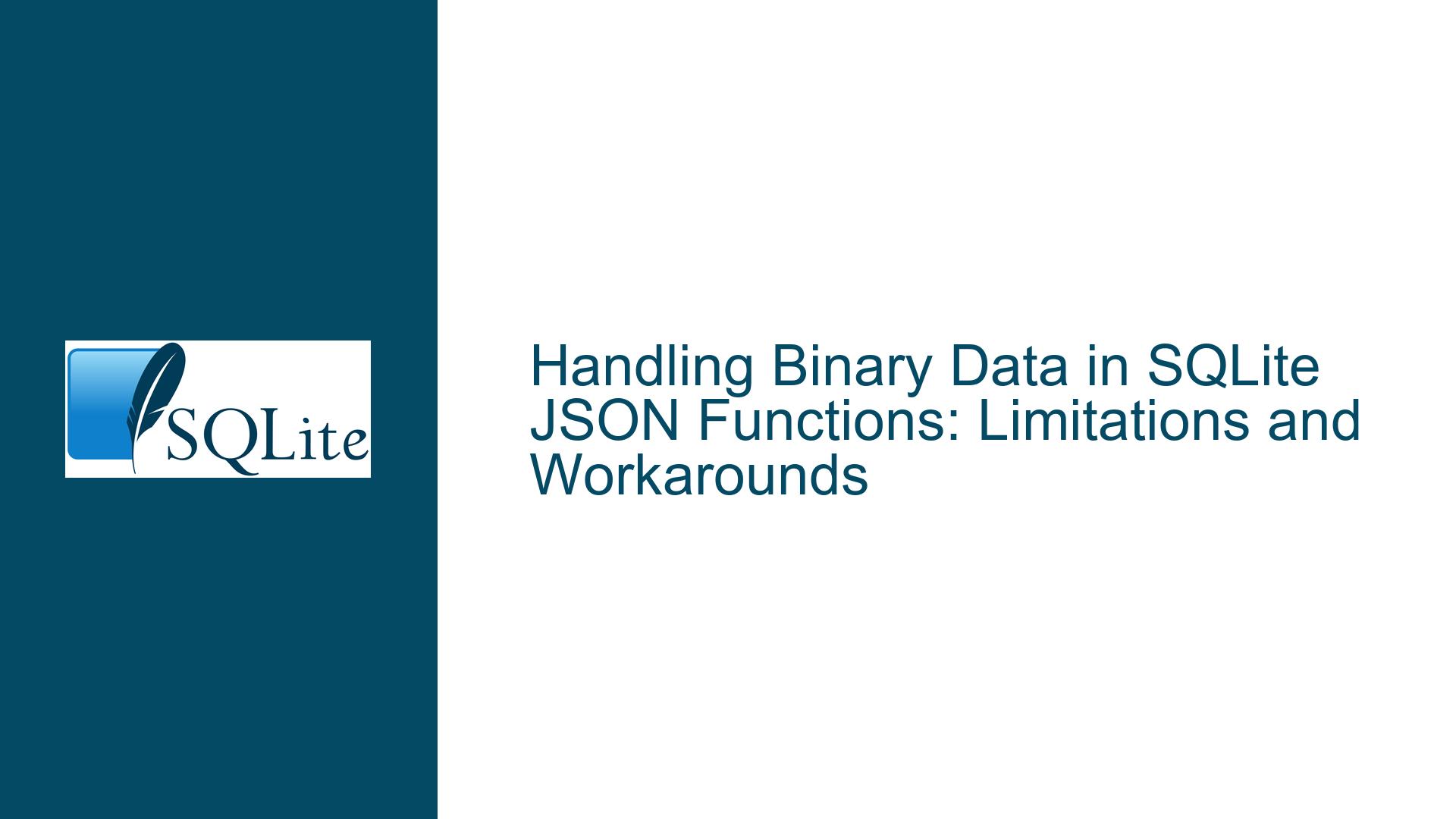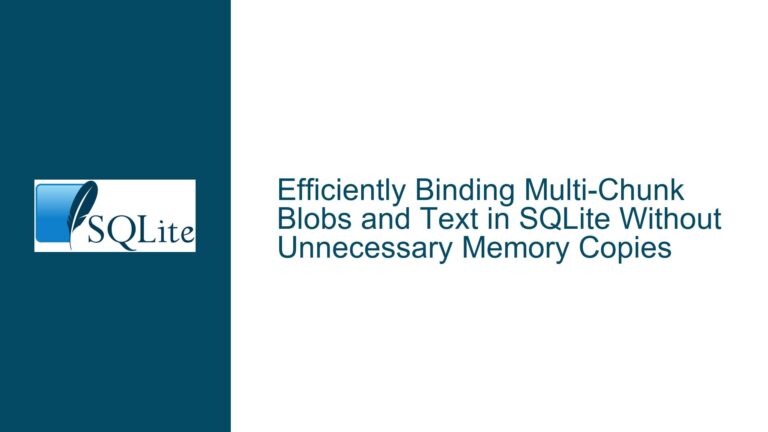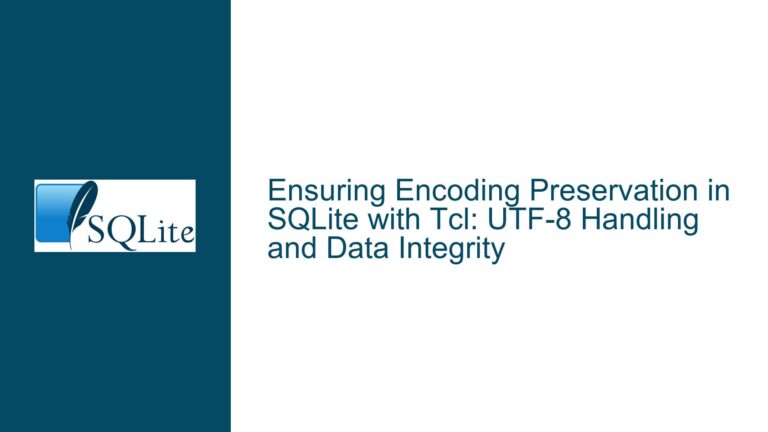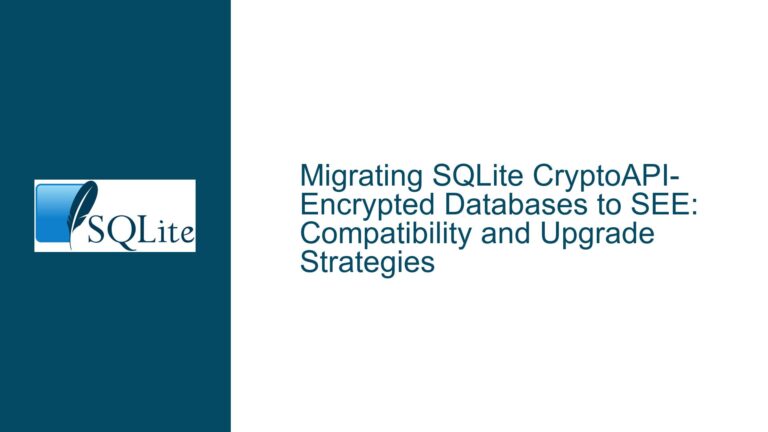Handling Binary Data in SQLite JSON Functions: Limitations and Workarounds
JSON’s Inability to Encode Binary Strings in SQLite
The core issue revolves around the inability of SQLite’s JSON functions to handle binary data directly. JSON, as a data interchange format, is designed to represent structured data using text-based key-value pairs and arrays. However, binary data, such as images, audio files, or other BLOB (Binary Large Object) types, cannot be natively encoded into JSON due to its text-based nature. This limitation becomes apparent when attempting to use SQLite’s json_object function to encode binary data, resulting in errors like JSON cannot hold BLOB values.
The JSON specification, as defined by json.org, does not include support for binary data encoding. While some JSON APIs or libraries may offer extensions like \x for escaping binary strings, these are not part of the official JSON grammar. SQLite adheres strictly to the JSON specification, which means it does not support such extensions. This adherence ensures compatibility and consistency across different systems and applications but also imposes limitations when dealing with binary data.
Why JSON Cannot Handle Binary Data and SQLite’s Constraints
The JSON specification defines a strict grammar for representing data, which includes strings, numbers, objects, arrays, and a few special values like true, false, and null. Strings in JSON are sequences of Unicode characters, and the specification provides escape sequences like \uNNNN for representing Unicode characters. However, these escape sequences are not suitable for encoding arbitrary binary data because they are designed to represent text, not raw bytes.
Binary data, on the other hand, consists of raw bytes that do not necessarily correspond to valid Unicode characters. Encoding binary data into JSON would require a mechanism to represent these bytes as text, which is not supported by the JSON specification. SQLite’s implementation of JSON functions follows this specification closely, which is why attempting to encode binary data using json_object results in an error.
Additionally, SQLite’s internal handling of BLOB values further complicates the matter. BLOBs are stored as raw binary data in SQLite databases, and there is no built-in mechanism to automatically convert this data into a JSON-compatible format. This limitation is particularly problematic when trying to serialize entire rows or columns into JSON, as any BLOB values in the data will cause the serialization to fail.
Serializing Binary Data to JSON in SQLite: Techniques and Best Practices
Despite the limitations, there are several techniques for serializing binary data into JSON in SQLite. These techniques involve converting the binary data into a text-based format that can be encoded into JSON. One common approach is to use hexadecimal encoding, which represents binary data as a string of hexadecimal digits. SQLite provides built-in functions like hex and unhex for this purpose.
The hex function converts a BLOB into a hexadecimal string, which can then be included in a JSON object. For example, if you have a BLOB column named img, you can serialize it into JSON using the following query:
SELECT json_object('img', hex(img)) FROM my_table;
This query converts the img column into a hexadecimal string and includes it in a JSON object. To deserialize the data, you can use the unhex function to convert the hexadecimal string back into a BLOB.
Another approach is to use Base64 encoding, which represents binary data as a string of ASCII characters. While SQLite does not provide built-in functions for Base64 encoding and decoding, you can implement these functions using user-defined functions (UDFs) or extensions. Base64 encoding is more compact than hexadecimal encoding and is widely used for encoding binary data in JSON.
If you need to handle multiple data types in the same column, you can use SQLite’s CASE construct to apply different encoding methods based on the data type. For example:
SELECT json_object(
'data',
CASE
WHEN typeof(data) = 'blob' THEN hex(data)
ELSE data
END
) FROM my_table;
This query checks the data type of the data column and applies hexadecimal encoding only if the data is a BLOB. This approach ensures that the JSON serialization process handles different data types correctly.
For more complex scenarios, such as serializing entire rows or columns into JSON, you can use SQLite’s json_group_object and json_group_array functions. These functions allow you to aggregate multiple rows or columns into a single JSON object or array. However, you must ensure that any binary data is properly encoded before using these functions.
In cases where you need to serialize data from triggers, you can use the NEW and OLD keywords to access the values of the affected rows. For example, the following trigger serializes the NEW row into a JSON object and stores it in a separate table:
CREATE TRIGGER serialize_after_update AFTER UPDATE ON my_table
BEGIN
INSERT INTO json_log (json_data)
VALUES (json_object(
'id', NEW.id,
'img', hex(NEW.img),
'other_column', NEW.other_column
));
END;
This trigger converts the img column into a hexadecimal string and includes it in the JSON object. The resulting JSON object is then stored in the json_log table.
While these techniques provide workarounds for encoding binary data into JSON, they come with trade-offs. Hexadecimal and Base64 encoding increase the size of the data, which can impact storage and performance. Additionally, the encoding and decoding processes add computational overhead. Therefore, it is essential to carefully consider the requirements of your application and choose the most appropriate encoding method.
In conclusion, while SQLite’s JSON functions do not natively support binary data, there are several techniques for encoding binary data into JSON-compatible formats. By using hexadecimal or Base64 encoding and leveraging SQLite’s built-in functions and constructs, you can successfully serialize binary data into JSON. However, these techniques require careful implementation and consideration of the trade-offs involved.






